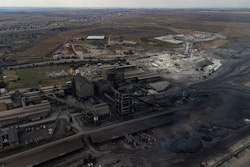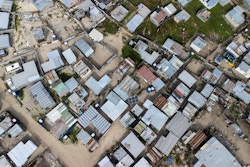South Africa: between power cuts and a just energy transition
As Energy Observer concludes her 80th stopover in Cape Town, her major stopover on the African continent, Beatrice Cordiano, on board scientist and energy expert, and Mélanie de Groot, on board reporter, give us an overview of the challenges of the energy transition in South Africa, currently going through one of the most serious energy crises in its history.
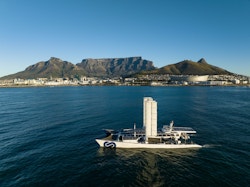
Energy Observer's arrival in Cape Town
They tell us about their own experience in the field and the difficulties the country is facing in changing its energy model, with the development of renewable energies - among other things - as a concrete and viable solution.

Beatrice Cordiano on board for the mythical passage of the Cape of Good Hope
A severe energy crisis
South Africa is entering the winter season of the southern hemisphere, anticipating the worst power cuts the country has ever experienced. This country is the second most advanced economy of the whole continent, yet here homes and businesses suffer frequent and extended blackouts because the national power utility, Eskom, is unable to meet the demand. We experienced this reality while we were there: at some point during the day the lights just switch off, leaving an entire neighbourhood in the darkness, without electricity, and the most incredible thing is that has become a normality and people do not even get surprised.
It is difficult to imagine how daily life can be affected when you lack electricity for up to 12 hours a day: you cannot charge your laptop, food in your freezer defrosts, you cannot do card payments, traffic lights don’t work. The lack of energy doesn’t come alone, its effects inevitably reverberate on a larger scale and South Africa’s economy is taking a hit too. These prolonged periods of darkness push crime rates up, increase unemployment rates, worsen inequalities, leaving behind a stagnant economy.
“In addition to reminding us of our heavy dependence on energy, the South African crisis shows us the extent to which decarbonization must go hand in hand with a genuine social justice policy.”
The core of this energy dilemma lies within diverse reasons: technical problems, corruption, a series of bad political choices and even acts of sabotage… The 15 coal-fired power stations Eskom runs -which assure the quasi-totality of the national power generation- are on the one hand too old and poorly designed, on the other hand inadequately maintained and operating at only 25% of their capacity causing daily shortfalls of 4 to 6 GW, namely more than 10% of the peak demand.
The solution the country has put in place so far is called load shedding: on a technical level, when the available amount of energy produced cannot meet the demand that businesses, civilians and structures need in order to run their daily operation, power is programmatically switched off in certain areas and distributed elsewhere. Then it rotates.
Currently this is the way South Africa is dealing with the scarcity of energy and the risk of a complete grid shutdown on a national level, but other solutions are possible and other pathways are investigated in this country which committed to progressively phase-out coal.
Phasing-out coal: a complex problem
Coal has historically dominated the energy sector in South Africa but for the country to reach its carbon emission reduction targets, that has to change. As of today, 70% of the primary energy consumption and more than 85% of the electricity production is provided by this resource. It is an immense industry which makes the country rank 14th in the list of the world’s largest emitters of greenhouse gases and 5th among the nations with the highest carbon intensity.

Victorien Erussard and Mélanie de Groot in Komati
At the same time, it has become a colossal fossil-based economy which employs 150 to 200 000 people and contributes to 480 billion rands, or 24 billion euros, to the country’s GDP. Getting rid of coal paying particular attention at the social and economic implications that an energy transition can have is not going to be trivial.
The Mpumalanga region, which we were able to visit, is entirely focused on the coal industry and brings to mind the world of the movie Mad Max, partly filmed here. The amount of emissions from coal-fired power plants is very high and NASA has identified this region as one of the world’s hotspot for sulfur dioxide emissions. Burning coal also emits CO2, nitrogen oxyde, methane, fluored gas, soot, ashes (containing mercury, lead, arsenic) sulfate and nitrate particles, creating dramatic public health issues.
In its Integrated Resource Plan (IRP), released in October 2019, the government officially confirmed the gradual phase-out of coal, and Eskom will have to shut down half of its 45 GW installed capacity by 2035. This situation is both reassuring and worrying. If nothing is done to support the local populations, there is a strong risk of ending up with a region doubly burdened by pollution and mass unemployment.
“The challenge for our transition, additionally is that those jobs are very concentrated in one location, the coalfields of Mpumalanga and that creates a big challenge because as we transition away from coal, the risk of ghost towns, particularly in Emahaleni, is very high. So that requires the need to act in favor of a just transition for those communities and all the depend on it more broadly.”
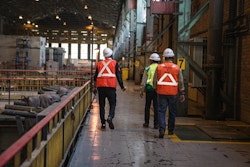
Victorien Erussard in Komati
Playing on 3 axes: renewables, hydrogen and EVs
With the current movement to fight climate change, future coal demand in the international markets is expected to decline and South Africa -whose coal is exported worldwide- will need to find new sources of energy and revenues.
The country has all the credentials to successfully decarbonise its economy and improve its current environmental performances: it is extremely rich in renewable energies, and the falling cost of electricity for PV and wind facilitates the game making these sources a valid and cost-effective low-emission alternative.
In Cape Town, the transition is already visible....from the sky. Dozens of houses there are already equipped with solar panels and batteries.

Victorien Erussard with Mary Haw, Energy Efficiency & Renewable Facilitation Manager at City of Cape Town
“Part of the way that the city of Cape Town is trying to mitigate against some of the impacts of load shedding is that we are buying from independent power producers and we also are supporting customers in putting on their own solar PV, generating excess. And for the first time those customers can actually get paid in cash when they generate more energy than they are using. So through a number of measures. We're trying to promote generation here in Cape Town.”
Renewables, hydrogen and electric vehicles (EVs) : these are the three top priorities South Africa has set. With the goal of increasing the renewable installed capacity to 31.2 GW by 2030 -about three times the current one- the government has recently scrapped the threshold of 100 MW on self-generation of power, meaning that power plants can be built without a license to meet their own demand and sell to the grid, taking pressure off Eskom and helping reduce the load shedding which holds back economic growth.
As you can imagine, the development of renewables go hand in hand with storage needs and that’s where hydrogen comes into play. With its geographical and climate advantages and its immense mines of platinum – a crucial metal in the construction of electrolysers, of which South Africa holds 74% of the global mine production- the country is expected to become an important export hub of green hydrogen, hitting one of the lowest costs worldwide of around $1.60 per kg by 2030. Finally, once the electricity will be greener, the decarbonisation of the automotive sector -which is the third emitter to date- will follow too, but for now an EV plugged into the national grid would emit more than a traditional petrol or diesel car.
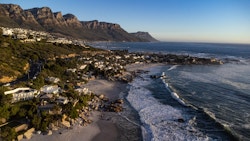
Energy Observer in Cape Town
South Africa is the perfect example of a country where a severe energy crisis will define its economic future and where the ability to respond to this crisis will set a clear path depending on the solutions that are adopted and the approaches that are taken.


